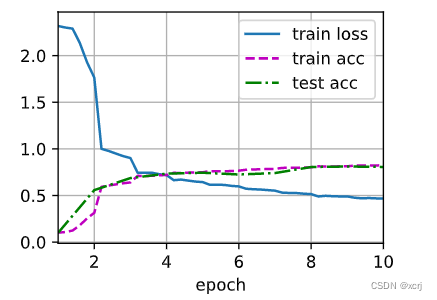28李沐动手学深度学习v2/卷积神经网络,LeNet
28李沐动手学深度学习v2/卷积神经网络,LeNet
·
LeNet实现
import torch
from torch import nn
from d2l import torch as d2l
class Reshape(torch.nn.Module):
def forward(self,x):
# view用来reshape,-1这一维由计算得出,1单通道
return x.view(-1,1,28,28)
net=nn.Sequential(
# reshape层。原来的图片是32*32的已经padding好了,现在28*28把padding删除了
Reshape(),
# 2维卷积,1输入通道数,6输出通道数,5x5,(28+2+2-5+1)/1=28
# 常用卷积核大小2x2,5x5,7x7,11x11;padding=核大小/2,为了降低输出的shape
nn.Conv2d(1,6,kernel_size=5,padding=2),
# 激活函数,非线性单元,可以由简单函数模拟复杂函数的关键
nn.Sigmoid(),
# 作用,降低卷积对位置的敏感度,一般放到卷积层之后
# 池化层对每个通道单独做池化,不改变通道数量
# (28+0+0-2+2)/2=16,通过stride减半输出shape
nn.AvgPool2d(kernel_size=2,stride=2),
# 6输入通道数,16输出通道数,通过增加输出通道保留信息
# (16+0+0-5+1)/1=10,stride默认就是1
nn.Conv2d(6,16,kernel_size=5),
nn.Sigmoid(),
# (10+0+0-2+2)/2=5
nn.AvgPool2d(kernel_size=2,stride=2),
# 展平层,展平之后才能进行全连接
nn.Flatten(),
# 通道数16*5*5,(输入单元数量,输出单元数量)
nn.Linear(16*5*5,120),
nn.Sigmoid(),
nn.Linear(120,84),
nn.Sigmoid(),
nn.Linear(84,10)
)
# 检查模型
# !1个输入,1个通道,28*28的图片
# !4个括号4个维度,shape看括号里面的元素数量
X=torch.rand(size=(1,1,28,28),dtype=torch.float32)
for layer in net:
X=layer(X)
print(layer.__class__.__name__,'output shape:\t',X.shape)
Reshape output shape: torch.Size([1, 1, 28, 28])
Conv2d output shape: torch.Size([1, 6, 28, 28])
Sigmoid output shape: torch.Size([1, 6, 28, 28])
AvgPool2d output shape: torch.Size([1, 6, 14, 14])
Conv2d output shape: torch.Size([1, 16, 10, 10])
Sigmoid output shape: torch.Size([1, 16, 10, 10])
AvgPool2d output shape: torch.Size([1, 16, 5, 5])
Flatten output shape: torch.Size([1, 400])
Linear output shape: torch.Size([1, 120])
Sigmoid output shape: torch.Size([1, 120])
Linear output shape: torch.Size([1, 84])
Sigmoid output shape: torch.Size([1, 84])
Linear output shape: torch.Size([1, 10])
# !4个括号4个维度,shape看括号里面的元素数量
# 第1个括号里面1个元素,第2个括号里面2个元素,第3个括号里面2个元素,第3个括号里面2个元素
torch.tensor([[
[
[1,2],
[3,4]
],
[
[1,2],
[3,4]
]
]]).shape
torch.Size([1, 2, 2, 2])
LeNet在Fashion-MNIST数据集上的表现
batch_size=256
train_iter,test_iter=d2l.load_data_fashion_mnist(batch_size=batch_size)
修改评估函数,在gpu上运行模型
def evaluate_accuracy_gpu(net,data_iter,device=None):
'''
评估精度,在gpu上运行模型
:return 平均精度=总精度/输出元素数量
'''
if isinstance(net,nn.Module):
# !!模型评估
net.eval()
# 如果device=None,没有给定设备,看第1个参数在那个设备上
if not device:
# net.Parameters()是可迭代对象
# next(iter(可迭代对象))获取可迭代对象的下1个值
# 这里next只调用了1次,就获取了第1个参数
# 迭代所有的参数获取每个参数的设备
device=next(iter(net.parameters())).device
# 创建2个维度的累加器
metric=d2l.Accumulator(2)
# 评估模型时不需要计算梯度
# 上下文管理器
# 进入with语句时自动调用__enter__()魔术方法
# 退出with语句时自动调用__exit__()魔术方法
with torch.no_grad():
for X,y in data_iter:
# 如果X是list类型
if isinstance(X,list):
# 以这种方式放入device
X=[x.to(device) for x in X]
else:
# 否则以这种方式放入device
X=X.to(device)
y=y.to(device)
# numel() 元素数量
metric.add(d2l.accuracy(net(X),y),y.numel())
# 平均精度=总精度/输出元素数量
return metric[0]/metric[1]
修改训练函数,在gpu上训练模型
def train_ch6(net,train_iter,test_iter,num_epochs,lr,device):
'''
在gpu上训练模型(在第六章定义)
'''
def init_weights(m):
if type(m)==nn.Linear or type(m)==nn.Conv2d:
# 数值稳定性,防止梯度爆炸和梯度消失
# 数值稳定性,前向每一层输出的方差应该尽量相等,后向梯度的方差应该尽量相等
# 数值稳定性,稳定输入输出,让每层的输出的方差差不多,防止开始训练时模型就梯度爆炸或消失
# 数值稳定性
# - 正向每层输出期望=0,方差为常数
# - 反向每层梯度期望=0,方差为常数
# xavier参数初始化,提高数值稳定性,防止梯度爆炸或消失
# - 数值稳定性,每一层输出的方差应该尽量相等,为此,每层的权重应该满足哪些条件
# - xavier参数初始化,防止梯度爆炸或消失
# - 限制参数的选择范围,使得最终的函数曲线更平滑,泛化能力更强
# - 它表示权重和梯度期望=0,权重和梯度的方差由第t层输入和输出的神经元数量决定
nn.init.xavier_uniform_(m.weight)
net.apply(init_weights)
print('training on', device)
# 将模型放到GPU上
net.to(device)
# 优化函数
optimizer = torch.optim.SGD(net.parameters(), lr=lr)
# 损失函数,交叉熵
loss = nn.CrossEntropyLoss()
# 动画展示损失函数
animator = d2l.Animator(xlabel='epoch',
xlim=[1, num_epochs],
legend=['train loss', 'train acc', 'test acc'])
# num_batches总批量数
timer, num_batches = d2l.Timer(), len(train_iter)
for epoch in range(num_epochs):
metric = d2l.Accumulator(3)
# !!训练
net.train()
# 获取索引i而使用枚举enumerate
for i, (X, y) in enumerate(train_iter):
timer.start()
# !清空梯度,默认会梯度累积
optimizer.zero_grad()
# !数据放到gpu上
# 在计算之前放到gpu上
X, y = X.to(device), y.to(device)
# !前向传播,魔法函数自动调用forward()
y_hat = net(X)
# !计算损失
l = loss(y_hat, y)
# !后向传播
l.backward()
# !优化1步
optimizer.step()
# 记录训练过程不需要计算梯度
# 什么时候不能计算梯度,需要梯度的变量在非训练步骤中不能计算梯度
with torch.no_grad():
metric.add(l * X.shape[0], d2l.accuracy(y_hat, y), X.shape[0])
timer.stop()
# l=loss,训练损失*样本数量/样本数量=训练损失
train_l = metric[0] / metric[2]
# 匹配label数量/样本数量=训练精度
train_acc = metric[1] / metric[2]
# //下取整,训练5个批量或到最后1个批量时输出1次
if (i + 1) % (num_batches // 5) == 0 or i == num_batches - 1:
animator.add(epoch + (i + 1) / num_batches,
(train_l, train_acc, None))
# 1epoch,验证1次平均精度
test_acc = evaluate_accuracy_gpu(net, test_iter)
# 绘图
animator.add(epoch + 1, (None, None, test_acc))
# l=loss
print(f'loss {train_l:.3f}, train acc {train_acc:.3f}, '
f'test acc {test_acc:.3f}')
# 耗时 样本总数量/耗时,1s中训练多少个样本
print(f'{metric[2] * num_epochs / timer.sum():.1f} examples/sec '
f'on {str(device)}')
开始训练
# 没有overfitting可能就是underfitting
lr, num_epochs = 0.9, 10
train_ch6(net, train_iter, test_iter, num_epochs, lr, d2l.try_gpu())
loss 0.467, train acc 0.824, test acc 0.807
48045.4 examples/sec on cuda:0

总结
涉及
- 数据(训练集 验证集合,测试集合)
- 模型
- 超参数
- 损失函数
- 优化函数 优化损失函数,获取模型参数
- 训练
- 评估
过程
- num_epochs
- 获取batch_size数据
- 数据放到设备上
- 前向传播
- 计算损失函数值
- 后向传播
- 优化函数优化1步
模型超参数
- 卷积层:kernel_size,padding,stride,channel
- 池化层:kernel_size,padding,stride
超参数
- num_epochs
- batch_size
- lr
正则化超参数
- weight_decay
- p 丢弃概率
没有overfitting可能就是underfitting
- overfitting后可以通过某些方式调整
query
卷积层的输出将输入宽高减半,通道数增加1倍
- 答:将抽象后的信息保存到了通道中。同样的1个像素保存了更多信息,更多的通道作用到了这1个像素中
view和reshape的区别
- 答:reshape的功能比view更强大。view视图是原有tensor的视图,不开辟新的存储空间,返回原有存储空间的引用。view只适用于连续性的tensor
6通道到16通道
- 答:16x6x二维卷积核
poloclub.github.io/cnn-explainer/
- 答:可视化cnn学到的东西

魔乐社区(Modelers.cn) 是一个中立、公益的人工智能社区,提供人工智能工具、模型、数据的托管、展示与应用协同服务,为人工智能开发及爱好者搭建开放的学习交流平台。社区通过理事会方式运作,由全产业链共同建设、共同运营、共同享有,推动国产AI生态繁荣发展。
更多推荐
 已为社区贡献2条内容
已为社区贡献2条内容







所有评论(0)